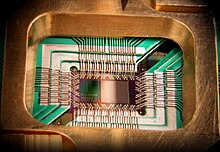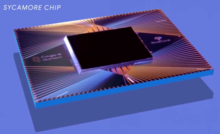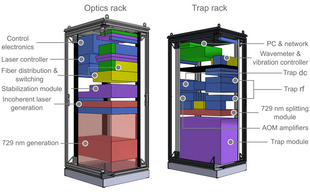2000s
2000
- Arun K. Pati and Samuel L. Braunstein prove the quantum no-deleting theorem. This is dual to the no-cloning theorem which shows that one cannot delete a copy of an unknown qubit. Together with the stronger no-cloning theorem, the no-deleting theorem has the implication that quantum information can neither be created nor be destroyed.
- The first working 5-qubit NMR computer is demonstrated at the Technical University of Munich, Germany.
- The first execution of order finding (part of Shor's algorithm) at IBM's Almaden Research Center and Stanford University is demonstrated.
- The first working 7-qubit NMR computer is demonstrated at the Los Alamos National Laboratory in New Mexico.
- The textbook, Quantum Computation and Quantum Information, by Michael Nielsen and Isaac Chuang is published.
2001
- The first execution of Shor's algorithm at IBM's Almaden Research Center and Stanford University is demonstrated. The number 15 was factored using 1018 identical molecules, each containing seven active nuclear spins.
- Noah Linden and Sandu Popescu prove that the presence of entanglement is a necessary condition for a large class of quantum protocols. This, coupled with Braunstein's result (see 1999 above), called the validity of NMR quantum computation into question.[40]
- Emanuel Knill, Raymond Laflamme, and Gerard Milburn show that optical quantum computing is possible with single-photon sources, linear optical elements, and single-photon detectors, establishing the field of linear optical quantum computing.
- Robert Raussendorf and Hans Jürgen Briegel propose measurement-based quantum computation.[41]
2002
- The Quantum Information Science and Technology Roadmapping Project, involving some of the main participants in the field, lays out the Quantum computation roadmap.
- The Institute for Quantum Computing is established at the University of Waterloo in Waterloo, Ontario by Mike Lazaridis, Raymond Laflamme and Michele Mosca.[42]
- A group led by Gerhard Birkl (now at TU Darmstadt) demonstrates the first 2D array of optical tweezers with trapped atoms for quantum computation with atomic qubits.[43]
2003
- Implementation of the Deutsch–Jozsa algorithm on an ion-trap quantum computer at the University of Innsbruck is reported.[44]
- Todd D. Pittman and collaborators at Johns Hopkins University, Applied Physics Laboratory, and independently Jeremy L. O'Brien and collaborators at the University of Queensland, demonstrate quantum controlled-not gates using only linear optical elements.[45][46]
- The first implementation of a CNOT quantum gate, according to the Cirac–Zoller proposal, is reported by a team at the University of Innsbruck led by Rainer Blatt.[47]
- The DARPA Quantum Network becomes fully operational on October 23, 2003.
- The Institute for Quantum Optics and Quantum Information (IQOQI) is established in Innsbruck and Vienna, Austria, by the founding directors Rainer Blatt, Hans Jürgen Briegel, Rudolf Grimm, Anton Zeilinger and Peter Zoller.
2004
- The first working pure state NMR quantum computer (based on parahydrogen) is demonstrated at Oxford University, England and University of York, England.
- Physicists at the University of Innsbruck show deterministic quantum-state teleportation between a pair of trapped calcium ions.[48]
- The first five-photon entanglement is demonstrated by Jian-Wei Pan's team at the University of Science and Technology of Chin; the minimal number of qubits required for universal quantum error correction.[49]
2005
- University of Illinois at Urbana–Champaign scientists demonstrate quantum entanglement of multiple characteristics, potentially allowing multiple qubits per particle.
- Two teams of physicists measure the capacitance of a Josephson junction for the first time. The methods could be used to measure the state of quantum bits in a quantum computer without disturbing the state.[50]
- In December, W-states of quantum registers with up to 8 qubits implemented using trapped ions are demonstrated at the Institute for Quantum Optics and Quantum Information and the University of Innsbruck in Austria.[51]
- Harvard University and Georgia Institute of Technology researchers succeed in transferring quantum information between "quantum memories" – from atoms to photons and back again.[citation needed]
2006
- The Materials Science Department of Oxford University, England cage a qubit in a "buckyball" (a molecule of buckminsterfullerene) and demonstrated quantum "bang-bang" error correction.[52]
- Researchers from the University of Illinois at Urbana–Champaign use the Zeno Effect, repeatedly measuring the properties of a photon to gradually change it without actually allowing the photon to reach the program, to search a database using counterfactual quantum computation.[53]
- Vlatko Vedral of the University of Leeds and colleagues at the universities of Porto and Vienna find that the photons in ordinary laser light can be quantum mechanically entangled with the vibrations of a macroscopic mirror.[54]
- Samuel L. Braunstein at the University of York along with the University of Tokyo and the Japan Science and Technology Agency give the first experimental demonstration of quantum telecloning.[55]
- Professors at the University of Sheffield develop a means to efficiently produce and manipulate individual photons at high efficiency at room temperature.[56]
- A new error checking method is theorized for Josephson junction computers.[57]
- The first 12-qubit quantum computer is benchmarked by researchers at the Institute for Quantum Computing and the Perimeter Institute for Theoretical Physics in Waterloo, Ontario as well as at MIT, Cambridge.[58]
- A two-dimensional ion trap is developed for quantum computing.[59]
- Seven atoms are placed in a stable line, a step on the way to constructing a quantum gate, at the University of Bonn.[60]
- A team at Delft University of Technology in the Netherlands creates a device that can manipulate the "up" or "down" spin-states of electrons on quantum dots.[61]
- The University of Arkansas develops quantum dot molecules.[62]
- The spinning new theory on particle spin brings science closer to quantum computing.[63]
- The University of Copenhagen develops quantum teleportation between photons and atoms.[64]
- University of Camerino scientists develop a theory of macroscopic object entanglement, which has implications for the development of quantum repeaters.[65]
- Tai-Chang Chiang, at Illinois at Urbana–Champaign, finds that quantum coherence can be maintained in mixed-material systems.[66]
- Cristophe Boehme, University of Utah, demonstrates the feasibility of reading data using the nuclear spin on a silicon-phosphorus Kane quantum computer.[67]
2007
- Subwavelength waveguide is developed for light.[68]
- A single-photon emitter for optical fibers is developed.[69]
- The first one-way quantum computers are built,[70] where measurement (collapse) of an entangled cluster state is the main driving force of computation,[71] and shown to perform simple computations, such as Deutsch's algorithm.[72]
- A new material is proposed for quantum computing.[73]
- A single-atom single-photon server is devised.[74]
- The University of Cambridge develops an electron quantum pump.[75]
- A superior method of qubit coupling is developed.[76]
- A successful demonstration of controllably coupled qubits is reported.[77]
- A breakthrough in applying spin-based electronics to silicon is reported.[78]
- Scientists demonstrate a quantum state exchange between light and matter.[79]
- A diamond quantum register is developed.[80]
- Controlled-NOT quantum gates on a pair of superconducting quantum bits are realized.[81]
- Scientists contain and study hundreds of individual atoms in 3D array.[82]
- Nitrogen in a buckyball molecule is used in quantum computing.[83]
- A large number of electrons are quantum coupled.[84]
- Spin–orbit interaction of electrons are measured.[85]
- Atoms are quantum manipulated in laser light.[86]
- Light pulses are used to control electron spins.[87]
- Quantum effects are demonstrated across tens of nanometers.[88]
- Light pulses are used to accelerate quantum computing development.[89]
- A quantum RAM blueprint is unveiled.[90]
- A model of a quantum transistor is developed.[91]
- Long distance entanglement is demonstrated.[92]
- Photonic quantum computing is used to factor a number by two independent labs.[93]
- A quantum bus is developed by two independent labs.[94]
- A superconducting quantum cable is developed.[95]
- The transmission of qubits is demonstrated.[96]
- Superior qubit material is devised.[97]
- A single-electron qubit memory is reported.[98]
- Bose–Einstein condensate quantum memory is developed.[99]
- D-Wave Systems demonstrates use of a 28-qubit quantum annealing computer.[100]
- A new cryonic method reduces decoherence and increases interaction distance, and thus quantum computing speed.[101]
- A photonic quantum computer is demonstrated.[102]
- Graphene quantum dot spin qubits are proposed.[103]
2008

- The HHL algorithm for solving linear equations is published.[104]
- Graphene quantum dot qubits are described.[105]
- Scientists succeed in storing a quantum bit.[106]
- 3D qubit-qutrit entanglement is demonstrated.[107]
- Analog quantum computing is devised.[108]
- Control of quantum tunneling is devised.[109]
- Entangled memory is developed.[110]
- A superior NOT gate is developed.[111]
- Qutrits are developed.[112]
- Quantum logic gate in optical fiber[113]
- A superior quantum Hall Effect is discovered.[114]
- Enduring spin states in quantum dots are reported.[115]
- Molecular magnets are proposed for quantum RAM.[116]
- Quasiparticles offer hope of stable quantum computers.[117]
- Image storage may have better storage of qubits is reported.[118]
- Quantum entangled images are reported.[119]
- Quantum state is intentionally altered in a molecule.[120]
- Electron position is controlled in a silicon circuit.[121]
- A superconducting electronic circuit pumps microwave photons.[122]
- Amplitude spectroscopy is developed.[123]
- A superior quantum computer test is developed.[124]
- An optical frequency comb is devised.[125]
- The concept of Quantum Darwinism is supported.[126]
- Hybrid qubit memory is developed.[127]
- A qubit is stored for over 1 second in an atomic nucleus.[128]
- Faster electron spin qubit switching and reading is developed.[129]
- The possibility of non-entanglement quantum computing is described.[130]
- D-Wave Systems claim to have produced a 128 qubit computer chip, though this claim had yet to be verified.[131]
2009
- Carbon 12 is purified for longer coherence times.[132]
- The lifetime of qubits is extended to hundreds of milliseconds.[133]
- Improved quantum control of photons is reported.[134]
- Quantum entanglement is demonstrated over 240 micrometres.[135]
- Qubit lifetime is extended by a factor of 1000.[136]
- The first electronic quantum processor is created.[137]
- Six-photon graph state entanglement is used to simulate the fractional statistics of anyons living in artificial spin-lattice models.[138]
- A single-molecule optical transistor is devised.[139]
- NIST is reads and writes individual qubits.[140]
- NIST demonstrates multiple computing operations on qubits.[141]
- The first large-scale topological cluster state quantum architecture is developed for atom-optics.[142]
- A combination of all of the fundamental elements required to perform scalable quantum computing through the use of qubits stored in the internal states of trapped atomic ions is shown.[143]
- Researchers at University of Bristol demonstrate Shor's algorithm on a silicon photonic chip.[144]
- Quantum Computing with an Electron Spin Ensemble is reported.[145]
- A so-called photon machine gun is developed for quantum computing.[146]
- The first universal programmable quantum computer is unveiled.[147]
- Scientists electrically control quantum states of electrons.[148]
- Google collaborates with D-Wave Systems on image search technology using quantum computing.[149]
- A method for synchronizing the properties of multiple coupled CJJ rf-SQUID flux qubits with a small spread of device parameters due to fabrication variations is demonstrated.[150]
- Universal Ion Trap Quantum Computation with decoherence free qubits is realized.[151]
- The first chip-scale quantum computer is reported.[152]





